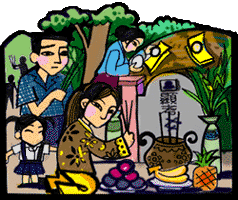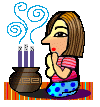 |
¡@
|
 ¡@The
Tomb-Sweeping Festival(Qing Ming Jie) is a time to pay respects to one's
ancestors and to tidy their gravesite. The date of this festival was set
as the third day of the third lunar month during the period of the Wei-Chin
Dynasties. In recent years it has been moved to April 5th. As the name of
this holiday suggests, the main activity of Tomb-Sweeping Day is for the
whole family, young and old, to go to the graveside of deceased family
members to burn incense and perform a ritual offering, while at the same
time clearing away plant overgrowth from the gravesite. ¡@The
Tomb-Sweeping Festival(Qing Ming Jie) is a time to pay respects to one's
ancestors and to tidy their gravesite. The date of this festival was set
as the third day of the third lunar month during the period of the Wei-Chin
Dynasties. In recent years it has been moved to April 5th. As the name of
this holiday suggests, the main activity of Tomb-Sweeping Day is for the
whole family, young and old, to go to the graveside of deceased family
members to burn incense and perform a ritual offering, while at the same
time clearing away plant overgrowth from the gravesite.
¡@Its Chinese name "Qing Ming" literally means "Clear
Brightness," hinting at its importance as a celebration of spring. Similar
to the spring festivals of other cultures, Tomb-Sweeping Day celebrates
the rebirth of nature, while marking the beginning of the planting season
and other outdoor activities.
¡@In ancient times, people celebrated Qing Ming Jie
with dancing, singing, picnics, and kite flying. Colored boiled eggs would
be broken to symbolize the opening of life. In the capital, the Emperor
would plant trees on the palace grounds to celebrate the renewing nature
of spring. In the villages, young men and women would court each other.
 ¡@Besides
the traditions of honoring the dead, people also often fly kits on Tomb
Sweeping Day. Kites can come in all kinds of shapes, sizes, and colors.
Designs could include frogs, dragonflies, butterflies, crabs, bats, and
storks. ¡@Besides
the traditions of honoring the dead, people also often fly kits on Tomb
Sweeping Day. Kites can come in all kinds of shapes, sizes, and colors.
Designs could include frogs, dragonflies, butterflies, crabs, bats, and
storks.
¡@With the passing of time, this celebration of life
became a day to the honor past ancestors. Following folk religion, the
Chinese believed that the spirits of deceased ancestors looked after the
family. Sacrifices of food and spirit money could keep them happy, and the
family would prosper through good harvests and more children.
Today, Chinese visit their family graves to tend to any underbrush that
has grown. Weeds are pulled, and dirt swept away, and the family will set
out offerings of food and spirit money. Unlike the sacrifices at a
family's home altar, the offerings at the tomb usually consist of dry,
bland food. One theory is that since any number of ghosts rome around a
grave area, the less appealing food will be consumed by the ancestors, and
not be plundered by strangers.
¡@ |
 ¡@The
Tomb-Sweeping Festival(Qing Ming Jie) is a time to pay respects to one's
ancestors and to tidy their gravesite. The date of this festival was set
as the third day of the third lunar month during the period of the Wei-Chin
Dynasties. In recent years it has been moved to April 5th. As the name of
this holiday suggests, the main activity of Tomb-Sweeping Day is for the
whole family, young and old, to go to the graveside of deceased family
members to burn incense and perform a ritual offering, while at the same
time clearing away plant overgrowth from the gravesite.
¡@The
Tomb-Sweeping Festival(Qing Ming Jie) is a time to pay respects to one's
ancestors and to tidy their gravesite. The date of this festival was set
as the third day of the third lunar month during the period of the Wei-Chin
Dynasties. In recent years it has been moved to April 5th. As the name of
this holiday suggests, the main activity of Tomb-Sweeping Day is for the
whole family, young and old, to go to the graveside of deceased family
members to burn incense and perform a ritual offering, while at the same
time clearing away plant overgrowth from the gravesite. ¡@Besides
the traditions of honoring the dead, people also often fly kits on Tomb
Sweeping Day. Kites can come in all kinds of shapes, sizes, and colors.
Designs could include frogs, dragonflies, butterflies, crabs, bats, and
storks.
¡@Besides
the traditions of honoring the dead, people also often fly kits on Tomb
Sweeping Day. Kites can come in all kinds of shapes, sizes, and colors.
Designs could include frogs, dragonflies, butterflies, crabs, bats, and
storks.